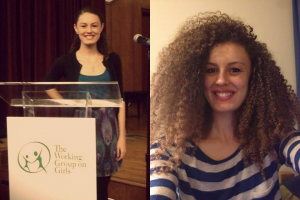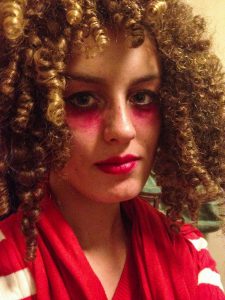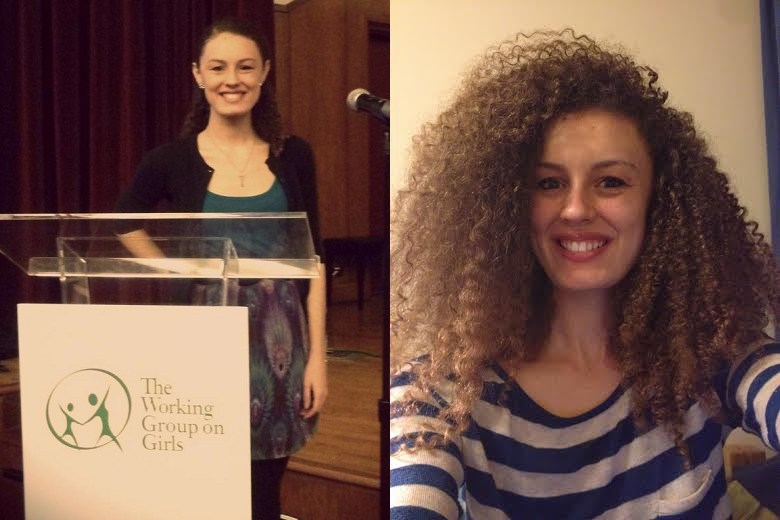by Annemarie McDaniel
On the first day of the New Year, I wore my hair down. All the way down. For girls with straight hair, this would just be a normal day, but for me–a girl with wild, curly hair–it felt monumental. The next day, and again the day after that, I let my curls reign again, not tucking or hiding any of it in ponytails. In 2013, I’d worn my hair 100% down exactly two times. But during just the first week of 2014, I broke my record by wearing it down three days in a row.
for me–a girl with wild, curly hair–it felt monumental. The next day, and again the day after that, I let my curls reign again, not tucking or hiding any of it in ponytails. In 2013, I’d worn my hair 100% down exactly two times. But during just the first week of 2014, I broke my record by wearing it down three days in a row.
I’m not a huge New Year’s resolutions person. On the first of January, I might write down places I want to go or things to improve upon, but I never follow this list strictly. But this year, I’ve been challenging myself to take on one of the hardest resolutions I can think of: wearing my hair 100% down once a week for the entire year.
I’ve fought the hair battle since before I can remember. For the first few years of my life, my hair felt tame, easy to tie into pigtails and be done with it. But the older I got, the more I had to fight every ringlet. I sat at the kitchen table every morning as my parents would try to comb and control my insane, intertwined curls. I remember my father tugging so hard I was almost in tears, and the sound of scissors cutting out tough knots or entangled hair ties. Once I reached middle school, I began using a relaxer to help loosen my curls. I tried to distract myself by watching television while my mom put in the chemicals, but I still remember clenching the chair in pain from my scalp feeling on fire.
 Other girls I knew chose other methods of styling their hair like dreadlocks, Afros, cornrows, weaves, and braids. But it seems that no matter what style we choose, women and girls of color are almost always criticized for our choices. I remember wearing a straighter style for my 8th grade graduation ceremony and struggling with two opposing thoughts in my head. One part of me felt I was betraying my half-black mother, who sported an Afro all of high school. I was denying my curls publicly, as if I was shouting to my fellow middle school students that I wanted to be more like them. More white. The other part of my mind loved having perfectly straight hair for a day. I could run my fingers through it without them getting caught, it shined when the light hit it, and it looked like it belonged to the beautiful girls on televisions or magazines. If I had worn my hair curly, I would have felt just as torn, feeling like a frizzy outsider in a sea of straight hair, but at least being myself. Especially as a mixed-race woman, I felt I was always straddling two worlds.
Other girls I knew chose other methods of styling their hair like dreadlocks, Afros, cornrows, weaves, and braids. But it seems that no matter what style we choose, women and girls of color are almost always criticized for our choices. I remember wearing a straighter style for my 8th grade graduation ceremony and struggling with two opposing thoughts in my head. One part of me felt I was betraying my half-black mother, who sported an Afro all of high school. I was denying my curls publicly, as if I was shouting to my fellow middle school students that I wanted to be more like them. More white. The other part of my mind loved having perfectly straight hair for a day. I could run my fingers through it without them getting caught, it shined when the light hit it, and it looked like it belonged to the beautiful girls on televisions or magazines. If I had worn my hair curly, I would have felt just as torn, feeling like a frizzy outsider in a sea of straight hair, but at least being myself. Especially as a mixed-race woman, I felt I was always straddling two worlds.
It’s a lose-lose situation.
It’s not rare either. Many black or mixed-race women struggle with how to wear their hair, in a world where certain styles are seen as less respectable. Last September, seven-year-old Tiana Parker, a straight-A student at Deborah Brown Community School, had to choose between her hairstyle and her education. School rules dictated that in order for students to look “presentable,” “Hairstyles such as dreadlocks, afros and other faddish styles are unacceptable.” This ban affects almost exclusively African-American students wearing their natural hair, and leaves few styling alternatives for girls. As seen at an Ohio charter school last June, other styles like the twisted braid or afro-puff are just as likely to be banned.
When schools ban historically black hairstyles from being worn at school, it is sending the message to girls that their natural hair texture isn’t respectable. Only painful, more ”white”-appearing alternatives, such as straighteners, weaves, or chemical relaxers, can be worn in public. When I, or other women with curls, dare to wear our natural hair to our school or to our job, we have to worry about retaliation. We have to worry about being sent home from school, like Tiana, or watching our employer fire us for “intimidating” ethnic hair, which Melphine Evans says she experienced at BP. Setting these standards on curly hair, whether explicit or not, shapes the lives and minds of black and mixed-race women everywhere.
texture isn’t respectable. Only painful, more ”white”-appearing alternatives, such as straighteners, weaves, or chemical relaxers, can be worn in public. When I, or other women with curls, dare to wear our natural hair to our school or to our job, we have to worry about retaliation. We have to worry about being sent home from school, like Tiana, or watching our employer fire us for “intimidating” ethnic hair, which Melphine Evans says she experienced at BP. Setting these standards on curly hair, whether explicit or not, shapes the lives and minds of black and mixed-race women everywhere.
Women are looked at as if our bodies (including hair!) determine our desirability. That’s why my New Year’s resolution feels so hard. Every day when I wear my hair down, I wonder if an acquaintance finds it empowering, if a cute peer finds it attractive, or if a potential employer finds it presentable. That’s also why it’s my favorite New Year’s resolution. Instead of constricting it with hair ties, I smile as it keeps poofing and frizzing and taking up space.
On days when I wear my hair down, I force myself to stop caring if others are looking. Instead of giving the power to the judging people in my life, I give it back to myself.

I have curly hair, too, and I mostly just let it do its own thing. I’m a very wash-and-wear type of gal. I, too, have vivid memories of a parent trying to brush or comb my hair and yelling in pain when they tried to pull the brush or comb through a snarl.
I recently learned that things that help keep straight hair healthy is damaging to curls, and that curly hair has its own needs. Your comment about straight hair being the ideal explains why nobody ever mentioned these differences. Either nobody ever thinks of us curlies or they assume we’ll submit to pressure and get it straightened. I personally like my curls, so I refuse to get rid of them.
You and your hair are beautiful the way the way they are. I love your curly hair. Not that it matters what I, or anyone else thinks. The sort of almost-subtle racism directed at people of colour by attacking their natural hair or traditional hair styles makes me mad. It is a another thread running through society telling people, particularly women and people of colour, that they are not right the way they are. Only change your hair if YOU fancy a change. Don’t change it for others. Keep the curls.
[…] McDaniels, “My Hardest New Years Resolution? Embracing my Curls” at […]